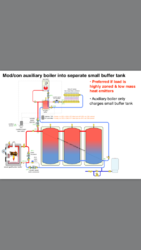Hi guys, I am having trouble wrapping my head around outdoor reset (ODR) control. I understand how ODR works, like cruise control for your car, only giving you the temperature that you require to heat you house depending on the outside temp, but this is where my confusion starts for my specific circumstances.
I am planning a house build this spring/summer. We want radiant in floor heat, but also want real hardwood floors, so I have been strongly considering Warmboard "S" for your subfloor as our only heating emitter on the upper 2 floors and pex in the concrete slab for the basement. I am thinking of a propane boiler to get us in the house and then in the next year or so a wood boiler with storage, and the propane will be our backup.
So I guess my question is how do you control an ODR system? Can I run the whole house on one water temperature? It will be pretty open concept, but I have come up with 20 btu/hr/sqft for the living room and like 10 btu/hr/sqft for the kitchen. So do I set my temp for the biggest load (living room) and then throttle back the valves for the kitchen, or does it not even matter since they will be so open to each other? What about smaller rooms like an office, powder room or bedrooms, wouldn't they over heat if they get the same temp as the living room? I would like to be able to change the temperature in the bedrooms depending who is using them. (if mom comes for a visit, or set them back until they are filled with kids)
When you change the temperature on ODR do you just have one controller and you shift the temperature line on the graph up or down so that the whole house moves together?? I was thinking of doing a manifold with actuators to control the zones, but if they are just going to be open all the time because the water temp is only just high enough to make up for the heat loss then they would just be a waste of money. Or would the water temperature be set for the biggest load (living room) and then use the same temp for the whole house and actuators with thermostats in the bedrooms, bathrooms and office to keep it from over heating.
That's enough for now I guess. So many questions it keeps me up at night . lol
I am planning a house build this spring/summer. We want radiant in floor heat, but also want real hardwood floors, so I have been strongly considering Warmboard "S" for your subfloor as our only heating emitter on the upper 2 floors and pex in the concrete slab for the basement. I am thinking of a propane boiler to get us in the house and then in the next year or so a wood boiler with storage, and the propane will be our backup.
So I guess my question is how do you control an ODR system? Can I run the whole house on one water temperature? It will be pretty open concept, but I have come up with 20 btu/hr/sqft for the living room and like 10 btu/hr/sqft for the kitchen. So do I set my temp for the biggest load (living room) and then throttle back the valves for the kitchen, or does it not even matter since they will be so open to each other? What about smaller rooms like an office, powder room or bedrooms, wouldn't they over heat if they get the same temp as the living room? I would like to be able to change the temperature in the bedrooms depending who is using them. (if mom comes for a visit, or set them back until they are filled with kids)

When you change the temperature on ODR do you just have one controller and you shift the temperature line on the graph up or down so that the whole house moves together?? I was thinking of doing a manifold with actuators to control the zones, but if they are just going to be open all the time because the water temp is only just high enough to make up for the heat loss then they would just be a waste of money. Or would the water temperature be set for the biggest load (living room) and then use the same temp for the whole house and actuators with thermostats in the bedrooms, bathrooms and office to keep it from over heating.
That's enough for now I guess. So many questions it keeps me up at night . lol


